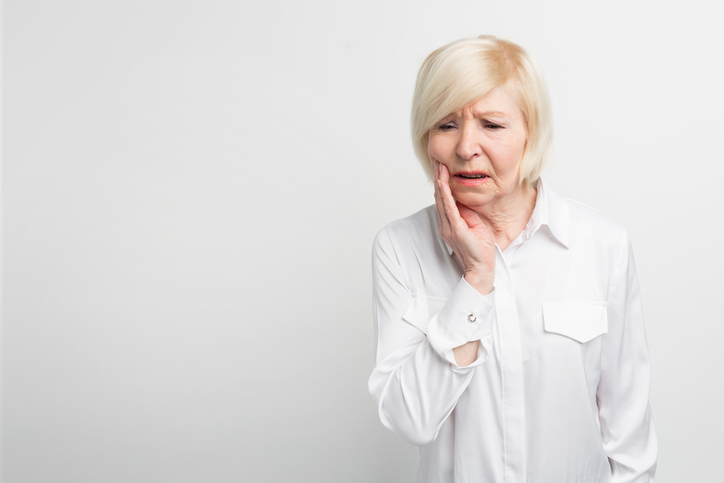Deviation opening to one side, can't move 1/2 distance to opposing side
Moderate damage to TMD is managed by Orofacial pain Specialist due complexity joint, complexity of chronic pain, and anxiety connection to pain. Chewing system orthopedic team is necessary to manage moderate damaged TMD. In chronic pain, the patient is most important member team.
Overlapping Pain Conditions:
Muscle damage or inflammation parallels the damage inside joint; so, a rule thumb is moderate level damage joint accompanies moderate (+) damage in muscles.
At initial examination, if moderate level of jaw joint damage, recent flare in jaw pain, or any slight increase symptoms, the following is recommended:
Refer orofacial pain specialist for best prognosis for your patient.
Restricted opening hints of moderated damage to TMD for dentist, hygienist. If the patient has an Urgent referral, visit an orofacial pain specialist to increase chance of recapture.
A general dentist may accept challenge to treat mild cases (muscle pain or partially displaced disc-click), but if the jaw pain moderate damage they refer to orofacial pain specialist.
Dentist & hygienist has three choices with restricted opening
Patient is referred back to dental professional or anesthiologist after healing and stabilization of TMD. Once jaw joint is stable-healed-nonpainful the open mouth procedure can be done w/o risk of pain flare.
Yes, a delay in care is concern, but the loving care that you show your patient to refer moderate damage in TMD to reduce pain & suffering is incredible.
Caution: if you suspect moderate damage in jaw joint, no open mouth procedure should be undertaken until jaw joint stability and healing have been confirmed by orofacial pain specialist.
Definition:
In English: Jaw joint bite is different than tooth bite.
In Dental: centric relations is different than centric occlusion
A few moderate damage jaw joints have small-moderate difference in dual bite.
Moderate-severe damage in TMD causes bite changes more than bite causes TMD
Completed displaced disc sudden loss causes condyle to elevate in fossa to load the posterior teeth on one side.
Bone loss in condylar head elevates the whole mandible in posterior to load the posterior teeth on one side.
Inside nerve verses outside nerve:
For anyone so brave and ego centric to think this is always clear, you need to go to endodontist or orofacial pain specialist office to shadow to learn the art of diagnosis difficult cases and respecting the level difficulty.
Deviation opening to one side, can't move 1/2 distance to opposing side
Moderate damage to TMD is managed by Orofacial pain Specialist due complexity joint, complexity of chronic pain, and anxiety connection to pain. Chewing system orthopedic team is necessary to manage moderate damaged TMD. In chronic pain, the patient is most important member team.
Overlapping Pain Conditions:
Muscle damage or inflammation parallels the damage inside joint; so, a rule thumb is moderate level damage joint accompanies moderate (+) damage in muscles.
At initial examination, if moderate level of jaw joint damage, recent flare in jaw pain, or any slight increase symptoms, the following is recommended:
Refer orofacial pain specialist for best prognosis for your patient.
Restricted opening hints of moderated damage to TMD for dentist, hygienist. If the patient has an Urgent referral, visit an orofacial pain specialist to increase chance of recapture.
A general dentist may accept challenge to treat mild cases (muscle pain or partially displaced disc-click), but if the jaw pain moderate damage they refer to orofacial pain specialist.
Dentist & hygienist has three choices with restricted opening
Patient is referred back to dental professional or anesthiologist after healing and stabilization of TMD. Once jaw joint is stable-healed-nonpainful the open mouth procedure can be done w/o risk of pain flare.
Yes, a delay in care is concern, but the loving care that you show your patient to refer moderate damage in TMD to reduce pain & suffering is incredible.
Caution: if you suspect moderate damage in jaw joint, no open mouth procedure should be undertaken until jaw joint stability and healing have been confirmed by orofacial pain specialist.
Definition:
In English: Jaw joint bite is different than tooth bite.
In Dental: centric relations is different than centric occlusion
A few moderate damage jaw joints have small-moderate difference in dual bite.
Moderate-severe damage in TMD causes bite changes more than bite causes TMD
Completed displaced disc sudden loss causes condyle to elevate in fossa to load the posterior teeth on one side.
Bone loss in condylar head elevates the whole mandible in posterior to load the posterior teeth on one side.
Inside nerve verses outside nerve:
For anyone so brave and ego centric to think this is always clear, you need to go to endodontist or orofacial pain specialist office to shadow to learn the art of diagnosis difficult cases and respecting the level difficulty.

 Raleigh Facial Pain © 2025 All Rights Reserved.
Raleigh Facial Pain © 2025 All Rights Reserved.